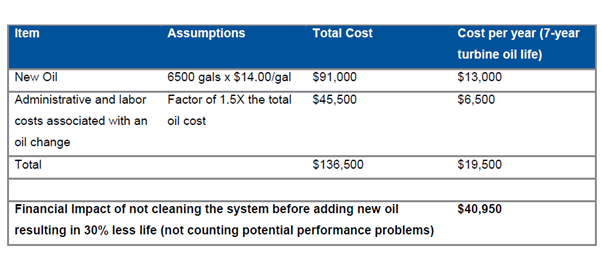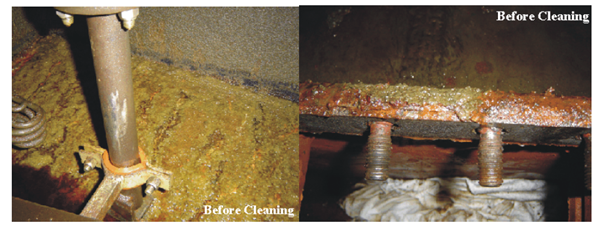Does It Matter If I Flush Or Not?!
Within the industry, the question of whether to flush between oil changes has been asked numerous times. “Is it cost effective, does it really make a difference to the system?” are also asked in tandem. Flushing is recommended in systems that have experienced varnish and in systems that have accumulated some form of contamination. Here are two examples where it would have been a wise decision to flush between oil changes.
Example 1: Impact of not cleaning a large frame gas turbine reservoir between oil changes
Problem:
The used oil in a large gas frame turbine was degraded and contributed to valve performance issues due to varnish. This used oil was drained and new oil added to the system without a flush being performed. However, within one week there was a decline in the RPVOT and RULER values while the MPC value was recorded outside of the normal range as seen in the table below.
Table 1: Adding new oil to a varnished gas turbine, significantly impacts the quality of the fluid.
Results:
- An estimated $40k loss and reduction of oil life by 30% since the flush was not done between oil changes
- System got contaminated from the used oil causing the new oil to experience rapid declines in the level of antioxidants and an increase in the MPC from 1 to 16 within one week
- Plant will now experience reliability and availability challenges since the oil has a significantly lower performance as shown in the table below
Table 2: Estimated financial impact of not cleaning the lube system between oil changes.
Example 2: The impact to oil life from adding new oil into a dirty system in a large ship’s controllable pitch propeller hydraulic fluid sump
Problem:
New oil was added to the hydraulic sump of the controllable pitch propeller system in a large ship. Initially, the new oil lasted for 5 years without any degradation of the fluid. After the first oil change, the system was not cleaned and another batch of fresh oil was added. However, this second batch of oil only lasted for 3 years before degradation was noticed. The second batch of oil was changed and a third batch of new oil added to the system. This third batch of oil only lasted for one year before degradation began as shown in figure 1 below. Upon examination of the sump, it was realized that there was a large range of deposits as shown in Figure 2.
 Figure 1: Life of the oil in a CPP system is approximately cut in half when new oil is put into a dirty system.
Figure 1: Life of the oil in a CPP system is approximately cut in half when new oil is put into a dirty system.
Results:
- Exponential loss of oil life when new is continually introduced into a contaminated system
- 40% oil life loss in first oil change
- 80% oil life loss in second oil change
 Figure 2: A wide range of deposit types were found during system cleaning. Photo courtesy of Clarus Fluid.
Figure 2: A wide range of deposit types were found during system cleaning. Photo courtesy of Clarus Fluid.
Conclusion
It is wise to flush a system between oil changes especially if the used oil contained varnish deposits or was contaminated in any way. Another alternative is to guarantee that the oil never gets contaminated or impacted by varnish deposits. This can be achieved through the combined use of Fluitec’s DECON™ with patent-pending Solvancer® technology and ESP™ (Electrophysical Separation Process) system. The addition of the DECON product to the system ensures that varnish deposits remain in solution while the ESP system can effectively remove these deposits from the system. Thus, this enables the system to remain clean and allows an extension of the oil life.


